May 29, 2020 marks 8 weeks since Paycheck Protection Program (PPP) loans were first made available and thus the beginning of borrowers’ eligibility to apply for loan forgiveness. On May 22, 2020, the SBA released two rules to help clarify various aspects of loan forgiveness and inform on the SBA’s review process, discussed below.
Loan Forgiveness Process: Lenders determine loan forgiveness on a borrower-by-borrower basis. To receive loan forgiveness, borrowers must complete and submit the Loan Forgiveness Application (or a lender’s equivalent) to their lenders. Lenders have 60 days from the date the Loan Forgiveness Application is submitted to issue its decision to the SBA, which in turn has 90 days to remit the appropriate forgiveness amount to the lender. (For a more detailed discussion on what costs qualify as forgivable, see our prior post here.)
Alternative Payroll Covered Period: Borrowers are not required to base forgiveness amounts on the 8-week period that begins with the date of disbursement. Instead, borrowers may opt to use an 8-week period beginning on the first day of the first payroll cycle after loan funds are disbursed (the “alternative payroll covered period”). For example, if a borrower receives its PPP disbursement on June 1, but the borrower’s first pay cycle after disbursement begins on June 7, the borrower may elect to calculate its loan forgiveness amount by using the period from June 7 to August 1 (8 weeks after June 7).
Costs Incurred but not Paid During Covered (or Alternative Covered) Payroll Period: Payroll costs incurred during the borrower’s last pay period of the covered period (or alternative payroll covered period) are eligible for forgiveness if paid on or before the next regular payroll date; otherwise, payroll costs must be paid during the covered period (or alternative payroll covered period) to be eligible for forgiveness. Additionally, non-payroll costs that are otherwise eligible for forgiveness and are incurred within the covered period or alternative covered period and paid on or before the next regular billing date are also eligible for forgiveness. For example, a rent or utility payment paid after the designated 8-week covered period can still qualify for loan forgiveness to the extent the payments were for rent or utilities incurred during said period. However, advance payments for interest on mortgage obligations do not qualify for forgiveness.
Payroll Caps: Payroll costs are forgivable to the extent that they cover employees’ salary, wages, or commissions during the covered or alternative covered period and do not exceed a prorated annual salary of $100,000. This also applies to bonuses, hazard pay, and the salary, wages, or commissions paid to furloughed employees. Further, the amount of loan forgiveness requested for owner-employees and self-employed individuals’ payroll compensation can be no more than the lesser of 8/52 of 2019 compensation (i.e., approximately 15.38 percent of 2019 compensation) or $15,385 per individual in total across all businesses.
Reductions to Loan Forgiveness Amounts: The CARES Act provides that a borrower’s loan forgiveness amount will be reduced if a borrower reduces its full-time equivalent (FTE) employees (meaning 40 hours or more of work each week) or reduces any employees’ (who made less than $100,000 in 2019) salary or wages by more than 25%. The CARES Act also allows borrowers to avoid such reductions if employees are rehired and restored salary and wage levels by June 30, 2020. The May 22nd interim rules clarify that borrowers may still be entitled to avoid such forgiveness reductions so long as they offer to rehire FTE employees or restore employees’ hours, even if they do not accept. Such offers must be made in good faith and be for the same salary, wages, and number of hours that the employee earned prior to separation or reduction in hours. Records of these offers and rejections must also be maintained, and the borrower must inform the applicable state unemployment insurance offer within 30 days of the employee’s rejection. Moreover, to ensure that borrowers are not doubly penalized, salary/wage reductions apply only to the portion of the decline in employee salary and wages that are not attributable to an FTE employee reduction. Further, if an employee is fired for cause, voluntarily resigns, or voluntarily requests a schedule reduction, then no corresponding loan forgiveness reduction will be imposed.
SBA’s Review Process: As discussed in our prior post addressing borrowers’ potential liability under the False Claims Act, all PPP loans in excess of $2 million, and any other loans “as appropriate,” will be reviewed by the SBA. Either way, if the SBA reviews a borrower’s loan, it will look at borrower eligibility, loan amounts and use of proceeds, and loan forgiveness. Borrowers are required to maintain PPP documentation for six years after the date the loan is forgiven or repaid in full and must permit the SBA access to such files upon request. If the SBA believes that a borrower may not have been eligible for the loan, the loan amount, or the loan forgiveness amount, the SBA will require the lender to contact the borrower in writing to request additional information and may also request information directly from the borrower. If the SBA determines that a PPP loan recipient should have been ineligible, no forgiveness will be permitted. The SBA may also seek repayment of the outstanding PPP loan balance or pursue other available remedies. Another interim rule will be issued that addresses how recipients ruled ineligible can appeal such a determination.
Modifications Expected: On May 28, 2020, the U.S. House of Representatives approved legislation (the “Paycheck Protection Flexibility Act,” H.R. 7010), that would extend the time PPP recipients have to spend their funds and receive forgiveness from eight weeks to 24 weeks. The bill would also lower the portion of PPP funds borrowers must spend on payroll costs to qualify for full loan forgiveness from 75% to 60%. The House bill passed under special rules established to expedite legislation while the House is not in full session, requiring a two-thirds vote for passage instead of a simple majority. The House bill will now need to pass the Senate before making its way to President Trump’s desk to be signed into effect. A separate bill advancing through the Senate would double the covered period of forgivable PPP spending to 16 weeks but would not change the 75% payroll cost requirement. We will continue to track these bills and provide updates accordingly.
Stubbs Alderton Authors:
Caroline Cherkassky
Garett Hill
For more information on worker’s rights and business liability, visit our COVID-19 Preccelerator Resource Center :
https://preccelerator.com/category/covid-19-resources/


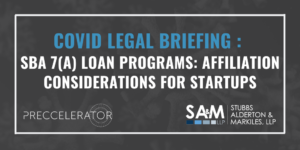 The Coronavirus Aid, Relief, and Economic Security (CARES) Act was recently signed into law, and includes, among other things, a new loan type under the 7(a) loan program of the Small Business Administration (SBA), called the Paycheck Protection Program (PPP). Also available under the SBA framework are
The Coronavirus Aid, Relief, and Economic Security (CARES) Act was recently signed into law, and includes, among other things, a new loan type under the 7(a) loan program of the Small Business Administration (SBA), called the Paycheck Protection Program (PPP). Also available under the SBA framework are 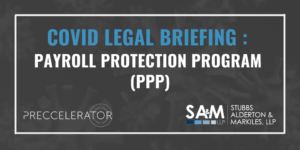 Making payroll is one of the most stressful issues on every business owner’s mind, and thankfully, the Paycheck Protection Program (PPP) section of the CARES Act provides significant aid to provide some financial relief. The final PPP loan application is now available
Making payroll is one of the most stressful issues on every business owner’s mind, and thankfully, the Paycheck Protection Program (PPP) section of the CARES Act provides significant aid to provide some financial relief. The final PPP loan application is now available 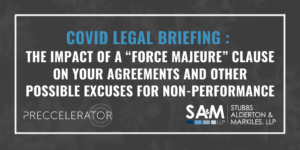 Force Majeure provisions in an agreement may excuse performance by one or both parties to a contract as a result of events that can neither be anticipated nor controlled. These provisions range from simple and boilerplate to extraordinarily detailed. But you may also be excused from performance of a contract if performance of the agreement impossible or impracticable.
Force Majeure provisions in an agreement may excuse performance by one or both parties to a contract as a result of events that can neither be anticipated nor controlled. These provisions range from simple and boilerplate to extraordinarily detailed. But you may also be excused from performance of a contract if performance of the agreement impossible or impracticable.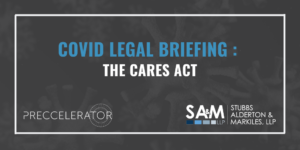 Signed into law on March 27, 2020, The Coronavirus Aid, Relief and Economic Security Act — or “CARES Act”, among other things, provides significant relief for small businesses. The Act injects roughly $2 trillion into the economy for coronavirus relief – providing roughly $350 billion in small business loans and an additional $500 billion in relief to distressed companies in distressed industries, expanding unemployment compensation, and providing rebate checks/tax relief to individuals, families and businesses. This relief is intended to last 3 months.
Signed into law on March 27, 2020, The Coronavirus Aid, Relief and Economic Security Act — or “CARES Act”, among other things, provides significant relief for small businesses. The Act injects roughly $2 trillion into the economy for coronavirus relief – providing roughly $350 billion in small business loans and an additional $500 billion in relief to distressed companies in distressed industries, expanding unemployment compensation, and providing rebate checks/tax relief to individuals, families and businesses. This relief is intended to last 3 months.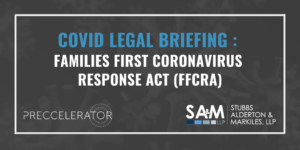 Families First Coronavirus Response Act (FFCRA)
Families First Coronavirus Response Act (FFCRA)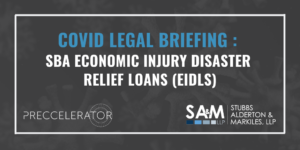 The U.S. Small Business Administration (SBA) has announced that it has made Economic Injury Disaster Relief Loans (EIDLs) of up to $2 million available to qualifying small businesses suffering substantial economic injury as a result of the Coronavirus (COVID-19). An EIDL is a working capital loan to help qualifying small businesses to meet their ordinary and necessary financial obligations that cannot be met as a direct result of the disaster. These loans are intended to assist through the disaster recovery period. The interest rate for small businesses is 3.75%, while the interest rate for non-profit organizations is 2.75%.
The U.S. Small Business Administration (SBA) has announced that it has made Economic Injury Disaster Relief Loans (EIDLs) of up to $2 million available to qualifying small businesses suffering substantial economic injury as a result of the Coronavirus (COVID-19). An EIDL is a working capital loan to help qualifying small businesses to meet their ordinary and necessary financial obligations that cannot be met as a direct result of the disaster. These loans are intended to assist through the disaster recovery period. The interest rate for small businesses is 3.75%, while the interest rate for non-profit organizations is 2.75%.